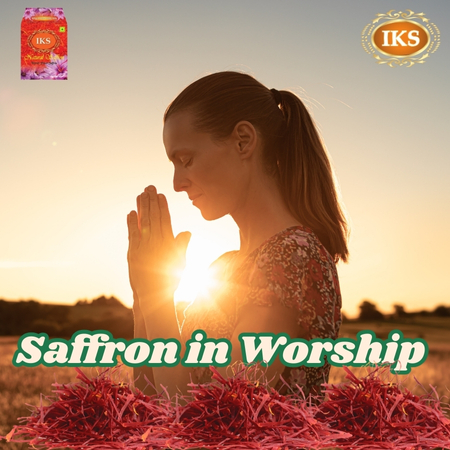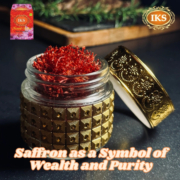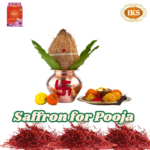Saffron in Worship: A Sacred Spice
Saffron in Worship: A Sacred Spice
Introduction
Saffron in Worship – Saffron is not only treasured for its culinary uses and medicinal properties but also holds a profound place in religious and spiritual practices. This precious spice, derived from the stigmas of the Crocus sativus flower, has been integral to worship rituals across various cultures and religions for centuries.
This article explores the significance of saffron in worship, its historical and cultural contexts, and its role in enhancing spiritual experiences.
Discover the Sacred Role of Saffron: Buy Saffron Now! 🌟📖
The Historical and Cultural Significance of Saffron
Ancient Civilizations and Saffron
Saffron in Ancient Persia
In ancient Persia, saffron was considered a divine gift and was used extensively in religious ceremonies. The Zoroastrians, followers of one of the world’s oldest monotheistic religions, used saffron to dye ceremonial garments and prepare sacred offerings.
Saffron’s golden hue was seen as a representation of light and purity, symbolizing the presence of the divine.
Saffron in Ancient Greece and Rome
The Greeks and Romans also held saffron in high regard. In ancient Greece, saffron was associated with the goddess Eos, the bringer of dawn, and was used in rituals to invoke her blessings.
Similarly, in ancient Rome, saffron was used in religious ceremonies and to anoint sacred statues. The Romans believed that saffron’s vibrant color and aroma had the power to purify and sanctify.
Saffron in Eastern Religions
Saffron in Hinduism
In Hinduism, saffron, known as “kesar” or “kumkum,” holds a sacred place. It is used in various religious rituals, ceremonies, and festivals.
Saffron paste is applied to the foreheads of deities and devotees as a mark of sanctity and devotion. The saffron tilak, a mark made on the forehead, symbolizes purity, auspiciousness, and the divine presence.
Saffron in Buddhism
In Buddhism, saffron is symbolic of renunciation and purity. Buddhist monks and nuns wear saffron-colored robes as a symbol of their commitment to the monastic life and their detachment from worldly desires.
The color saffron represents wisdom, humility, and spiritual awakening. Saffron is also used in Buddhist rituals and offerings.
Saffron in Middle Eastern Religions
Saffron in Islam
In Islamic tradition, saffron is valued for its purity and is used in various religious practices. It is often used to perfume mosques and prayer areas, creating a sacred and serene atmosphere.
Saffron is also used in traditional Islamic medicine (Unani) for its healing properties. During Ramadan, saffron-infused beverages and dishes are prepared to break the fast, symbolizing purity and nourishment.
Unlock the Spiritual Benefits of Saffron: Buy Kesar Online! 🌸✨
The Role of Saffron in Worship Rituals
Saffron in Hindu Worship
Religious Offerings and Ceremonies
In Hindu worship, saffron is a key ingredient in religious offerings (puja). It is used to prepare “prasadam,” sacred food offered to deities and later distributed among devotees.
Saffron is also mixed with water to create “kumkum,” which is applied to idols and worshippers as a mark of devotion. During festivals like Navaratri, Diwali, and Holi, saffron is used to decorate altars and prepare festive dishes.
Sacred Symbolism
The use of saffron in Hindu worship symbolizes purity, devotion, and the divine presence. Its golden color is associated with the sun and fire, representing energy, light, and life. Applying zaffran tilak is believed to protect the devotee from negative energies and bring divine blessings.
Saffron in Buddhist Worship
Monastic Robes
In Buddhism, the saffron-colored robes worn by monks and nuns are a symbol of their renunciation of worldly life and dedication to spiritual practice. The color saffron represents purity, humility, and the quest for enlightenment. These robes are dyed with natural saffron or turmeric to achieve the distinctive hue.
Rituals and Offerings
Saffron is used in various Buddhist rituals and offerings. It is often mixed with water to create a fragrant solution used to purify sacred objects and spaces. Saffron threads are also offered at altars as a symbol of devotion and reverence.
2 GRAMS IKS KASHMIR SAFFRON IN WORSHIP
Saffron in Islamic Worship
Purification and Perfuming
In Islamic worship, the use of saffron is linked to its purifying and fragrant properties. Saffron is used to perfume mosques and prayer areas, creating an ambiance of tranquility and sacredness. The fragrance of saffron is believed to uplift the spirit and enhance the experience of prayer.
Traditional Practices
During Ramadan, saffron-infused foods and beverages are prepared to break the fast. Saffron milk and sweets symbolize purity, nourishment, and the blessings of the holy month. The use of saffron in these practices reflects its esteemed status in Islamic tradition.
Enhance Your Worship Rituals with Saffron: Best Kungumapoo Online! 🌿🙏
The Spiritual Benefits of Saffron
Enhancing Meditation and Spiritual Practices
Saffron is believed to have a calming and uplifting effect on the mind and spirit. The fragrance of saffron can enhance meditation and spiritual practices by creating a serene and focused environment. Inhaling the aroma of saffron is thought to promote clarity, concentration, and inner peace.
Symbolizing Purity and Devotion
The use of saffron in worship symbolizes purity and devotion. Its golden hue represents the divine light and presence, inspiring reverence and spiritual aspiration. Saffron’s symbolic significance enhances the sanctity of religious rituals and deepens the spiritual experience of devotees.
Healing and Well-Being
Saffron is also valued for its healing properties. In traditional medicine systems like Ayurveda and Unani, saffron is used to treat various ailments and promote overall well-being. The use of saffron in religious rituals is believed to purify the body and soul, bringing physical and spiritual healing.
Unlock the Power of Saffron in Spirituality: Dive In! 🌿✨
How to Use Saffron in Worship
Preparing Saffron for Rituals
Soaking and Infusion
To prepare saffron for worship rituals, it is often soaked in warm water or milk to release its color and fragrance. This saffron-infused liquid can be used to anoint deities, sprinkle on altars, or mix with other sacred substances.
Making Saffron Paste
Saffron paste is commonly used in Hindu rituals. To make saffron paste, soak a few saffron threads in a small amount of water or milk for a few minutes. Grind the soaked threads into a fine paste using a mortar and pestle. This paste can be applied to deities, used to mark sacred symbols, or mixed with other ritual substances.
Incorporating Saffron in Offerings
Saffron Rice and Sweets
Saffron rice and sweets are commonly prepared as religious offerings. To make saffron rice, soak saffron threads in warm water or milk and add to the rice while cooking. The saffron imparts a golden color and rich flavor to the rice. Saffron sweets like kheer (rice pudding) and halwa are also popular offerings, made by adding saffron to milk-based desserts.
Saffron Water and Milk
Saffron-infused water and milk are used in various rituals. To make saffron water, soak a few saffron threads in warm water for a few minutes. This water can be used to purify sacred objects, sprinkle on altars, or offer to deities. Saffron milk, made by adding saffron threads to warm milk, is often offered as a sacred beverage.
Using Saffron in Personal Devotion
Saffron Tilak and Anointment
For personal devotion, saffron tilak can be applied to the forehead as a mark of sanctity and devotion. To make saffron tilak, soak a few saffron threads in water or milk and apply the resulting paste to the forehead. This practice is believed to bring divine blessings and protection.
Saffron Incense and Fragrance
Saffron incense and essential oils can be used to create a fragrant and serene environment for personal worship and meditation. The soothing aroma of saffron enhances the spiritual atmosphere and promotes relaxation and focus.
Conclusion
Saffron’s significance in worship spans across various cultures and religions, symbolizing purity, devotion, and the divine presence. From ancient Persia to modern-day Hinduism, Buddhism, and Islam, saffron has been an integral part of religious rituals and spiritual practices.
Its unique properties and symbolic meanings enhance the sanctity of worship and provide a deeper connection to the divine. By incorporating saffron into your spiritual practices, you can experience its profound benefits and embrace the rich traditions associated with this sacred spice.
Embrace the Sacredness of Saffron: Pure Saffron Threads! 🧡📖










Leave a Reply
Want to join the discussion?Feel free to contribute!